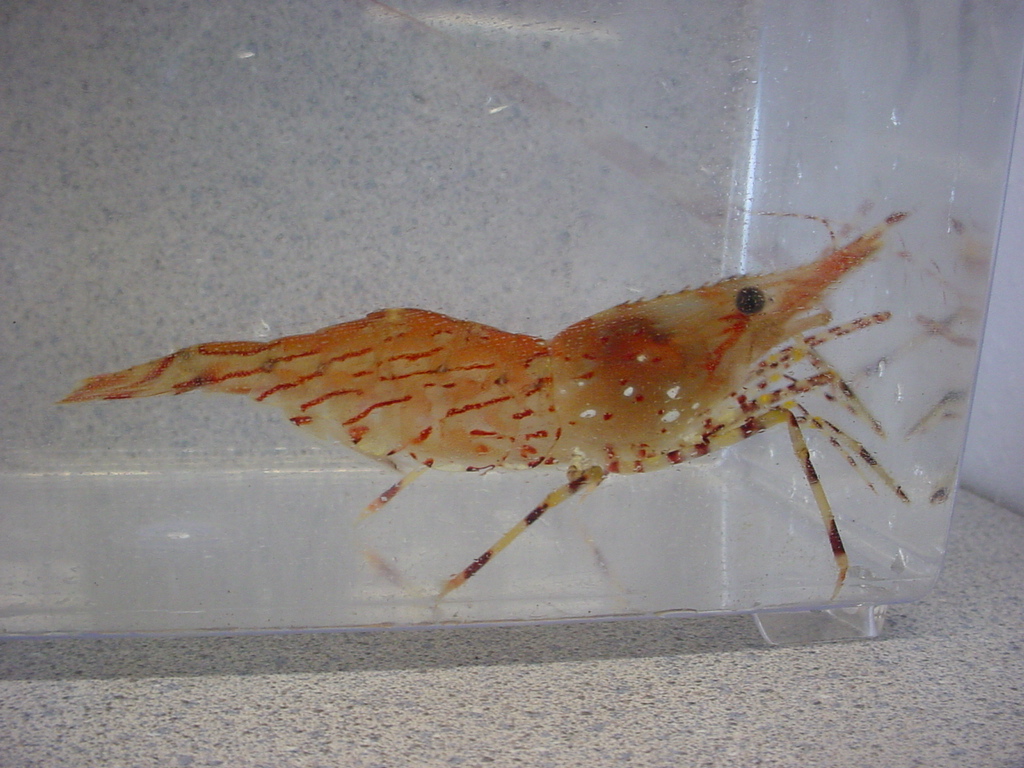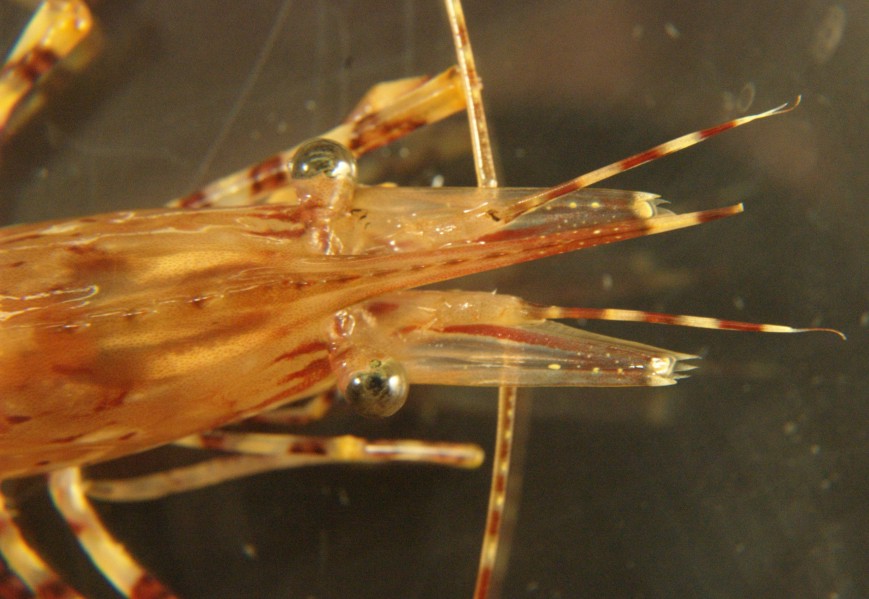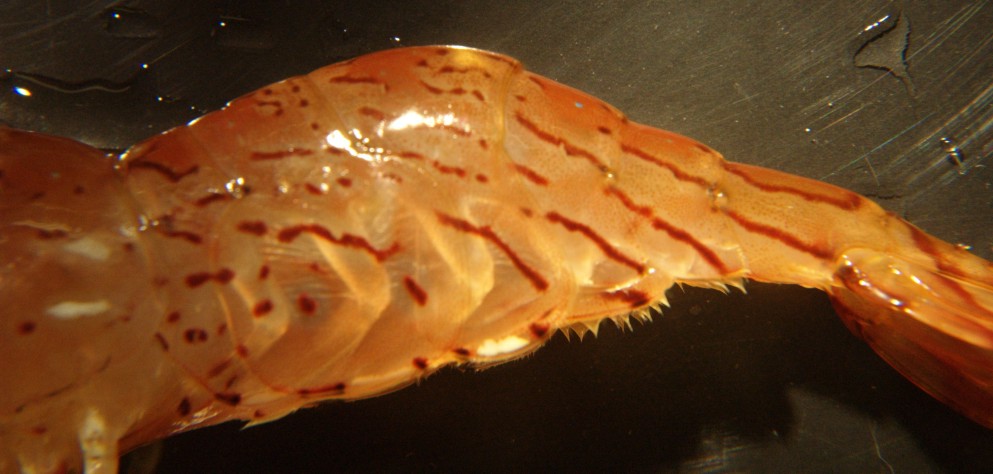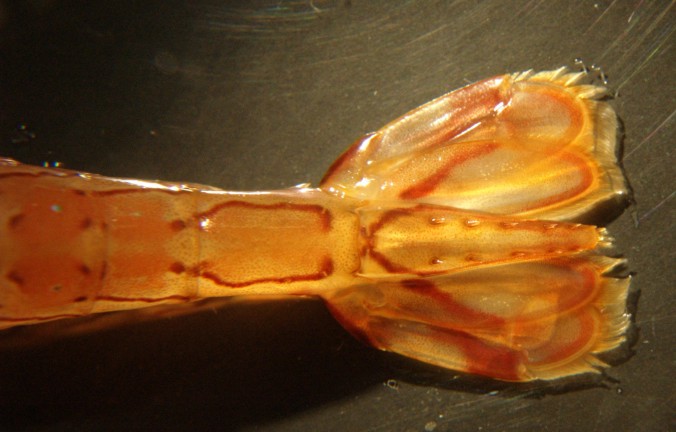Pandalus danae Stimpson, 1857Common name(s): Dock shrimp, coon-stripe shrimp |
|
| Synonyms: |  |
| Phylum Arthropoda
Subphylum Crustacea Class Malacostraca Subclass Eumalacostraca Superorder Eucarida Order Decapoda Suborder Pleocyemata Infraorder Caridea (true shrimp) Family Pandalidae |
|
| Pandalus danae, about 8 cm long, from 100 m depth in San Juan Channel | |
| (Photo by: Dave Cowles, July 2004) | |
How to Distinguish from Similar Species: Pandalus stenolepis has 3-5 pairs of small lateral spines on the telson and the outer margin of its antennal scale is concave. Although it has reddish stripes on the sides of its abdomen, they angle upward posteriorly rather than downward.
Note: According to the American Fisheries Society, this species should be called "dock shrimp" and the term "coonstripe shrimp" should be reserved for P. hypsinotus
Geographical Range: Alaska to Monterey, CA
Depth Range: Adults are just subtidal to 185 m. Juveniles live shallower and may even be low intertidal.
Habitat: Rocky and sandy benthic or often found on docks.
Biology/Natural History:
Live on rocky or
sandy/shelly bottoms. Juveniles hide in rock crevices or
under algae
during the day. Eat polychaetes.
The left and right second
pereopods
are different from one another. The carpus
of the left pereopod
is divided (multiarticulated)
into about 60 articles, while the right has 18-21. Predators
include
lingcod and pelagic cormorants. The species are protandrous hermaphrodites
(male first, then female). After the female molts in November
they
mate. The female carries her eggs on the abdomen
until April, when they hatch into pelagic
(swimming) larvae. The species can live for up to 3 years.
| Return to: | |||
| Main Page | Alphabetic Index | Systematic Index | Glossary |
References:
Dichotomous Keys:Flora and Fairbanks, 1966
Kozloff 1987, 1996
Lamb and Hanby, 2005
Smith and Carlton, 1975
Wicksten, 2009
General References:
Gotshall
and Laurent, 1979
Kozloff,
1993
Lamb
and Hanby, 2005
O'Clair
and O'Clair, 1998
Scientific Articles:
Komai, T., 1999. A revision of the genus Pandalus (Crustacea:
Decapoda: Caridea: Pandalidae). Journal of Natural History
33: pp
1265-1372
General Notes and Observations: Locations, abundances, unusual behaviors:
This species is fished for sport and commercially. It is one of the most commonly encountered large shrimp in our area found shallowly and on docks.

Top view of Pandalus danae head. Photo by
Dave Cowles,
July 1997
The telson has six pairs of spines running down the lateral edges of the dorsal side (note the last pair is very close to the end), plus terminal spines.

The spine is longer than the lamella on the antennal
scale.
Shrimp of this species are able to live on a remarkably small set of resources. Rosario Beach Marine Lab obtains its clean seawater from intake valves in the bay. Screens on these intakes filter out anything larger than about 1 mm. The water is pumped up into a large holding tank, then feeds by gravity down to our labs. The entire system is turned off and drained each mid-August at the end of the session, leaving only 10 cm or so of seawater and some silt at the bottom of the holding tank. The system is then locked up and remains closed until the next mid-June. In the summers of 2014 and 2015 we discovered individuals of this species living in the silt at the bottom of the holding tank when it was opened in June. This pale individual, about 12 cm total length (eye socket to telson), was the sole individual in the tank in June 2015. He would have had to have entered the system as a larva the previous summer, and had lived in continuous darkness with little food except other larvae and silt, for 10 months until the tank was opened. When first removed his eyes reflected light very brightly. This photo was taken about 2 weeks after he was removed from the tank. By this time his eyes no longer glow brightly. Photo by Dave Cowles, July 2015.
Authors and Editors of Page:
Dave Cowles (2005): Created original page



